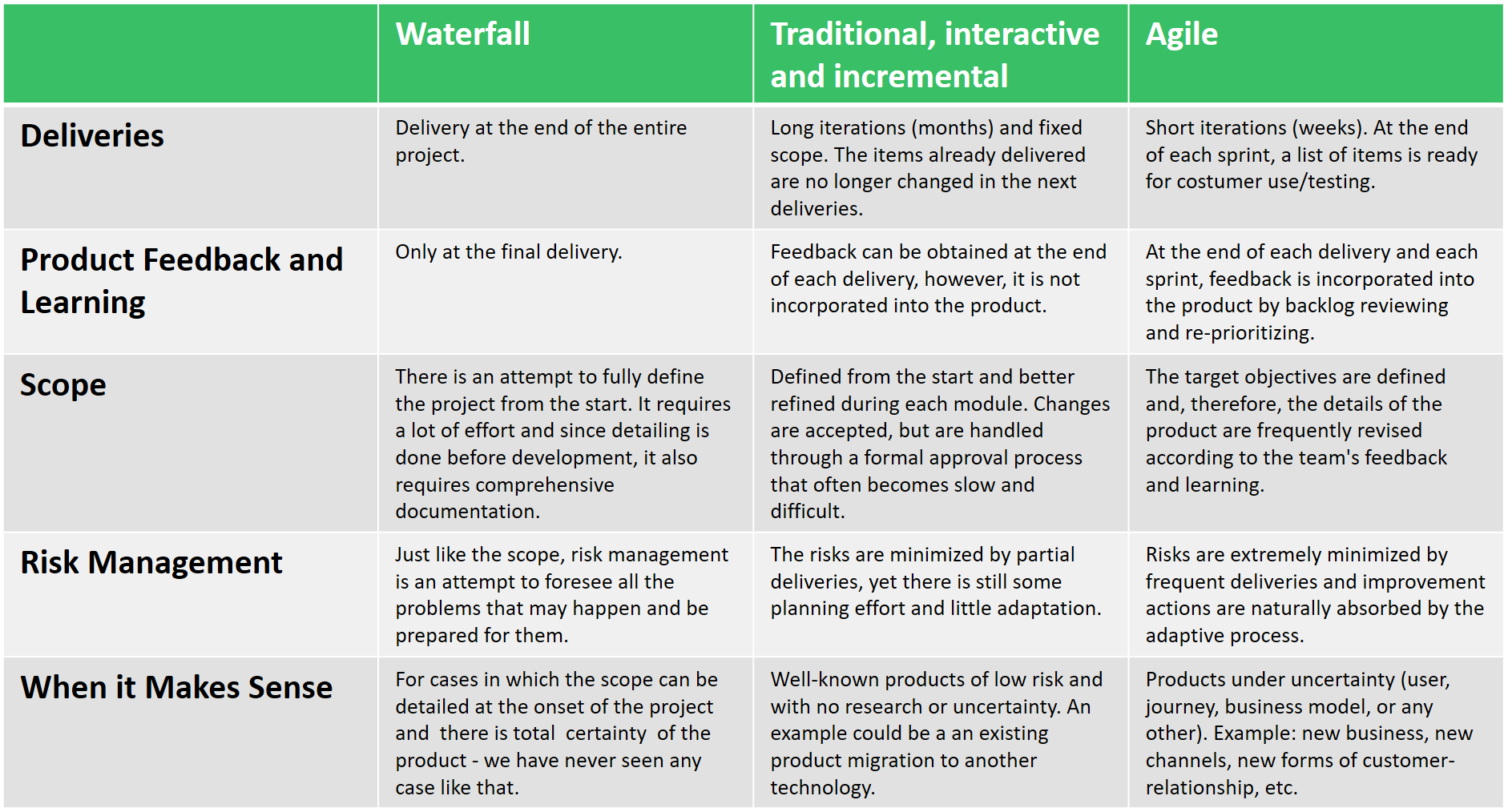When I started working with technology, 28 years ago, software development was built through a method called the Waterfall Model: one step at a time, sequentially performed. Each phase used to take longer and the outcome was comprehensive documentation. That allowed us to ‘forecast’ and plan product development, down to detail, (and its subsequent user acceptance), as well as define the project schedule and scope. At least two major problems originated from that Model. The first one was the distance between the user and the product, as deliveries consisting of large software packages were first available to the client months after they had been built. Just then could the client give some opinion about what was being developed. The second problem had to do with changes. Modifying items already delivered – and even pre-set schedule and scope – would depend on the contract, culture, and the hierarchy of the company. Thus, it could bring about some slowness and impair the pace of promptly responding to new business needs. The result was rework, frustration and dissatisfaction for all the actors involved in the process. In many companies, the Waterfall Model has resulted in delayed and over-budget projects, unhappy users, and discredited IT teams, secluded from other areas of the organization. Nowadays, some of these effects can still be detected, as the Waterfall is around lurking in the cubicles of those youngsters who “are building a simple system.”
IT discovers new working models
The difficulties caused by the predictive and sequential model have driven the emergence and dissemination of the
agile culture. This culture proposes a series of processes, practices, and tools for designing digital products, minimizing development risks through frequent deliveries and continual feedback. Agile methodology attempts to be adaptive rather than predictive. The assumption is that being able to incorporate what has been learned and uncovered on the way is more relevant than having a detailed plan. Even history has shown us that detailed plans are often incorrect. Scrum and Kanban, despite having their own tools, are examples of discipline and concern with transparency, supervision, and adaptation.
In Agile, predictability is not given by plans, but by monitoring actual data. Some of them are delivery pace, whether continuous or in short sprints, and user feedback on the product.
Differences between the Waterfall and the Agile methodologies.
Agility and Innovation
The agile methodology allows us to create a continuous flow of value delivery. We can test hypotheses,
collect feedback and make adjustments as we learn, providing the client with pace, risk reduction and predictability. Communication between the parties is frequent and transparent. Small deliveries allow everyone’s learning to be integrated into the product.
That is why Agility is one of the cornerstones of SoftDesign. It facilitates and organizes the software development process, making it experimental (from the product perspective!), and providing effective innovation. After all, if we are attempting to create an innovative product, it cannot take months to be launched and only then be evaluated, right? Innovation is the way by which consolidated companies achieve their differentiators, make profits, and sustain their own survival. Startups also rely on innovation to stand out, disseminate and grow. Innovation is essential because products, services, and experiences are copied, they become irrelevant, and that is because the market is constantly changing.
By creating a flow of performance and fast learning, the agile methodology contributes to digital transformation, which is the integration of technology in all areas of the business.
The goal is not only to change its modus operandi but also to deliver value to customers. It would be impossible for an IT team to support digital transformation using old work methods. They just do not deliver the same speed, confidence, and results as Agile. Innovation cannot be planned in detail: it requires experimenting and learning – likewise, experimenting cannot be performed chaotically, but rather driven by a method focused on delivery and results! In other words, the ‘IT sector’ journey in adopting the agile culture is essential to support companies through their digital transformation process. It runs much deeper than changing processes or tools. It involves issues such as role-changing, management models, and the foremost and hardest one to be achieved – change of mindsets.
Digital transformation consists of cultural changes that require people to constantly challenge the ‘status quo’, feel free to experiment and feel comfortable with likely failures. It is relevant here to point out that the real change is not only about what we are developing, a new product, service or process; or about what is being improved. It is also about how we do the development. There is no point in using methods that do not support learning about the product and the technology to create ‘the new’ or achieve improvements. We need a methodology that supports continuous adaptation and delivery of value. It is useless to seek new results by getting things done in the same ‘old way’.
As a company that offers Product Conception, Software Development, Consulting and Outsourcing services, we can assist partners in three ways:
Choosing one of the three options depends on the business needs and future objectives.
Contact us to find out the best way we can help you. 


